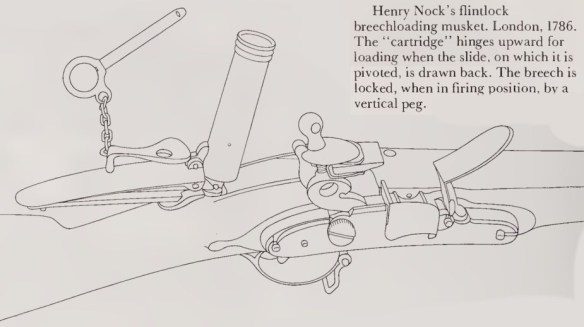In 1786 the leading London gunmaker Henry Nock devised one of the most satisfactory of all flintlock breechloaders. A reloadable cartridge which forms part of the breech is pivoted on a slide. When the slide is drawn towards the butt, the cartridge hinges upwards to a vertical position for loading. In the Firing position, in line with the barrel, it is locked by a vertical peg attached to a short chain which also serves as the handle when opening the breech. An example in the Tower Armouries shows that this was an efficiently-made arm, and much less complicated to use than its appearance would suggest. However, it had little success, although it was a considerable improvement over Guiseppi Crespi’s design of 1770, itself so like Bicknell’s breechloader of c. 1660.
Nock volley gun in the Charleston Museum. These guns were made 1779-1780 for the British Royal Navy. Nock’s Volley gun – 7 barrels brazed together with the outer 6 having their breeches plugged. The central barrel screwed on to a hollow spigot which formed the chamber and was connected to the vent. This chamber fired through smaller vents to ignite the charges in the outer barrels. At first, the barrels were all rifled but this led to loading difficulties and most were later made smooth bored. This improved the rate of fire but reduced range and accuracy.
The gun was made by James Wilson 1779 and named after Nock. Nock was contracted to manufacture the gun and 635 examples were sold to the Royal Navy. A flintlock mechanism fired through a vent that led to the central chamber. Firing cause dignition in the central chamber and resulting flash passed through and ignited the other 6 so all 7 fired more or less simultaneously. The gun was intended for the fighting tops of warships to fire down on the deck of the enemy vessel as it closed alongside. However recoil was so strong and the weapon so difficult to control that a smaller lighter version had to be produced. This made it shorter ranging but still effective as Admiral Howe’s fleet showed in relief of Gibraltar in 1782. Nevertheless, it was still unpopular because of the danger of a ship’s sails and rigging catching fire from the muzzle blast.
Overall length 37in, barrel length 20in, calibre 0.52in.
Henry Nock was also closely involved in the production of a volley gun offered by James Wilson to the British Board of Ordnance in 1779, when the inventor described it as “a new Invented Gun with seven barrels to fire at one time.” When the version with rifled barrels was recommended for use from ship’s rigging, Nock, who had made Wilson’s prototypes, supervised the manufacture between 1780 and 1788 of 655 at £13 each. Perhaps inspired by the interest shown by Colonel Thomas Thornton, several of London’s leading gunmakers made versions for game-shooting. The most distinctive survivor was the colonel’s own, an 11.5-lb (5.2 kg) sporting encumbrance by Dupe and Company with fourteen barrels in two sets of seven placed side by side. The gun is now in the Musee d’Armes, Liege. With the development of percussion ignition, the inventive Forsyth and Pauly designed neater seven-barreled sporting arms, and as late as 1900 the Belgian Henri Pieper made a rolling breech rifle firing seven .22-inch (5.6 mm) cartridges from seven barrels on a single pressure of the trigger. Pieper’s design was the last hand-held example of a series that began soon after the introduction of fire-arms and proceeded by way of a seven-barreled handgun mentioned in a Bastille inventory of 1453; sporting guns with several barrels drilled from a solid block; pistols with two, three or more barrels-of which the “duck’s foot pistol” is perhaps the best known -through J. Lillycrap’s patent of 1842, which shows a belt set with five pistol barrels that were fired simultaneously.
The appeal of the same idea to some artillerists resulted in the so-called “partridge mortar” of c. 1700, which had a large central bore surrounded by a ring of thirteen smaller bores firing one standard mortar shell and thirteen grenades. The vent of the parent barrel also gave fire to the smaller ones to produce an almost simultaneous discharge. Although never common or especially successful, they were used by the French in defense at Bouchain in 1702, and in attack at the siege of Lille six years later. One survives in the Museum fur deutsche Geschichte, Berlin.
Nebelwerfer trio werfing nebel. Company of Heroes computer game – I think not!
The psychological effect of these coveys of explosive shells must have been much the same in their day as the much more devastating clusters of rockets from the 5.9-inch (15 cm) Nebelwerfer 41 and its 8.3-inch (21 cm) successor, respectively six- and five-barreled, that rained down on the Allied armies at Cassino and later at the defensive complex occupied by the Wehrmacht east of the Orne. There, almost three hundred of these rocket-mortars were emplaced, each capable of discharging six rounds every 90 seconds at targets up to 7,700 yards (7,041 m) away.
